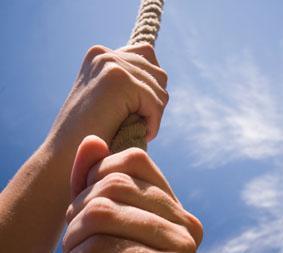A noise-induced hearing loss case dating back to exposure in the late 1970s could set a new precedent for historical claims. Muireann Bolger speaks to experts who warn that the flood gates may be about to open on an already surging market
Last year, a 51-year-old woman made legal history when she won a court battle against her former employer for noise-induced deafness, delivering a major jolt to insurers. Six years ago, Stephanie Baker began to experience hearing problems and occasional ringing in her ears, known as tinnitus. She proceeded to sue Quantum Clothing Group, which owned the factory where she had worked for 20 years until 1991, for noise damage after medical tests proved her hearing was impaired.
Initially, the odds were stacked against her. Baker had been subjected to noise levels in the late 1970s that were not recognised as causing injury prior to 1990. As expected, the High Court dismissed the claim. But when Baker challenged the ruling, the Court of Appeal made a surprise ruling in her favour. While the award – £3,500 – was a relatively modest win, the case was regarded as a landmark: one that could potentially pave the way for a surge in hearing loss claims.
Over recent years, insurers have already seen the number of noise-related claims climb rapidly. Allianz and Zurich reported a 25% and 20% rise respectively, over the past 12 months alone. The claims are largely historical, from employees who worked in industry in the 1970s and 1980s. But the groundbreaking decision in the Baker case means that insurers might need to brace themselves for more.
Sound decisions
Before the Court of Appeal’s decision, it was held that employers were not responsible for any damage inflicted by exposure to noise levels of between 85 and 90 decibels prior to 1990, when such regulations came into force. But the Court effectively ruled that Baker’s employer should have been aware of the potential damage caused by these levels from 1978 onwards.
Insurers are now facing the prospect that anybody exposed to those noise levels in the workplace during that time frame could make a successful claim for hearing loss. The case is due to be heard in the Supreme Court this year and, if the ruling is upheld, it could create a massive new pool of potential claimants.
Baker’s lawyer, Wake Smith & Tofields partner and head of industrial diseases, Chris Fry, says: “We are looking at hundreds of thousands of people who were working unprotected in noise exposure of 85 to 90 decibels in the late 1970s and these people potentially now have the ability to claim whereas they otherwise wouldn’t have.”
Elsewhere, insurance litigation firm Keoghs partner Peter Kenworthy says that hearing loss cases now account for up the 70% of all of their disease claims. He argues that if claims continue to rise and are additionally fuelled by a possible precedent set by the Baker case, insurers could be facing a steep rise in legal costs disproportionate to the actual damages awarded.
He explains: “Deafness claims of minimal hearing loss are not worth a great deal – let’s say an average of £3,000. The problem we face on the insurance side is that the costs could be three or four times that level. You may be facing costs of £10,000 when you take into account after-the-event premiums and success fees.”
Insurers mainly attribute the rise of decades-old claims to the rise in aggressive advertising from claims farmers and claimant solicitors. They say the emergence of conditional fee agreements and the prospect of an attractive success fee over the past ten years have fuelled the drive in such industrial injury claims.
Allianz motor and casualty claims manager Martin Saunders says: “It is quite interesting because we don’t really have these industries in this country any more; we have not had them for some years. The question is why are we seeing an increase in claims at this point in time? I think it is due to claims organisations advertising their trade and attempting to draw people in on a ‘no win, no fee’ basis.”
Mike Klaiber, disease claims manager at Zurich, the insurer behind Quantum Clothing Group, believes the downturn has also played a role in the marked rise in claims. “It is accepted anecdotally that these are recession-based claims with works closing down, and claims farming and advertising has an impact. When people are made redundant or put out of work, they are more inclined to be attracted by advertising.”
Meanwhile, Aviva’s senior claims manager Ian Harvey believes any precedent set by the Baker case will continue to whet the appetite for hearing loss claims. “This of course increases the likelihood for a good number of law firms that specialise in this kind of work to dust off some of their cases and then get out there and look for new ones.”
Furthermore, while the statute of limitations states that claimants have three years to submit a personal injury claim from the time they are aware of their injury, it is at the court’s discretion to apply this time restriction.
Beachcroft partner Will Potts says the courts have shown a willingness to waive limitations in hearing loss claims in recent years, paving the way for a greater number of historical suits. “There have been a couple of decisions where the courts have essentially said that hearing loss is a gradual thing and it wouldn’t necessarily have been apparent to the claimant at the time when they were exposed to noise that they suffered an injury,” he says.
Other factors have played a role in the resurgence of decades-old claims. The development of the ABI tracing code has helped claimants and solicitors to root out former employers’ insurance liability policies and pursue a claim.
Meanwhile, it is now much easier for people to identify any potential noise-related damage than in the past. Nowadays, they have the option of simply popping into high street chains, such as Boots and Specsavers, for a free hearing test to determine if there are any problems.
It is not just the past that insurers need to worry about, however. In 2005, the Control of Noise at Work Regulations replaced the Noise at Work Regulations of 1989, introducing new requirements for employers’ to protect workers’ hearing. Consequently, there is potential for hearing loss claims to come from areas previously unaffected, such as concert venues, night clubs and call centres.
Keoghs believes the new threshold has brought an additional 1.6 million people to the potential pool of claimants. “It is something that may become more relevant. It is being implemented gradually – it didn’t come into force for the entertainment industry until 2008. I suspect that in the next few years, it will become apparent whether it is a big issue or not,” Potts says.
While future risks may emerge, undoubtedly it is the outcome of the Baker case that has the industry on tenterhooks. Klaiber believes it is unfair that employers – and their insurers – could now be held liable for breaches of responsibility that didn’t exist at the time of injury. “Effectively, the courts are applying the standards of today back years ago, and that is a difficulty,” he says.
Don’t panic
Garwyn’s disease and illness unit manager Chris Gibson argues that while the Baker case may increase the threshold of employers’ past responsibility, the burden of proof will prove a substantial bulwark to a deluge of claims. “Eighty-five decibels doesn’t necessarily cause damage in all individuals. Yes, it is going to impose a duty that wasn’t there previously, but at the end of the day there has to be evidence that injury has occurred.”
He points out the six other claimants who joined Baker in her suit failed to prove they had suffered noise-related damage. Additional consolation for insurers comes from another unlikely source. Fry points out that while insurers have been whipped into a panic over the recent ruling, the need for watertight medical evidence and time limitations will remain tough hurdles to overcome. For example, he adds that if there is evidence a person became aware of their hearing loss back in 1985, it is highly unlikely a court will look kindly on a claim made 25 years later.
So what can insurers do if hearing loss claims continue to spiral? Experts warn it is vital to avoid a knee-jerk reaction by paying out immediately on claims and to examine each case on its own merits. “I think that a proper investigation quite often throws up defences, whether they are causation defences or even limitation defences, where claims have been brought too late in the day,” Gibson says.
“I think there are many cases that are worth investigating to send a general message to claimant solicitors that all cases will be individually investigated and payments will only be made where there is proper liability established.”
Kenworthy adds that insurers should be vigilant in ensuring that forensic medical reports are up to scratch. “Quite often insurers will see reports from experts that perhaps don’t always adopt the correct forensic approach when preparing their report,” he explains.
“That can lead to all sorts of litigation issues. If the report is obtained by an expert that both sides trust, this again will address a large number of issues and will reduce costs dramatically. Some of these experts will prepare reports without being properly instructed on occasions, and that can lead to a whole new raft of questions and costs being incurred.”
It seems, however, that while the days of Britain’s industrial era might be long gone, it is only when the Baker case reaches its final conclusion that insurers will know whether the fallout of this past will remain a present and pressing concern. IT



































No comments yet